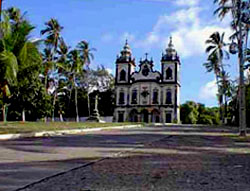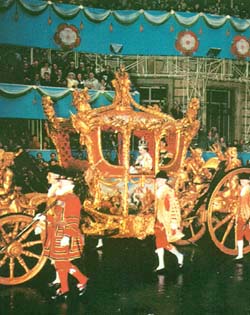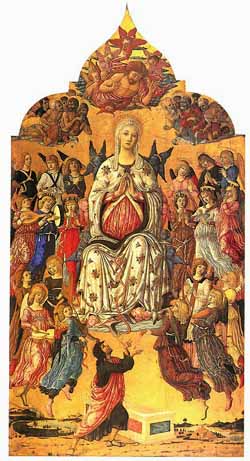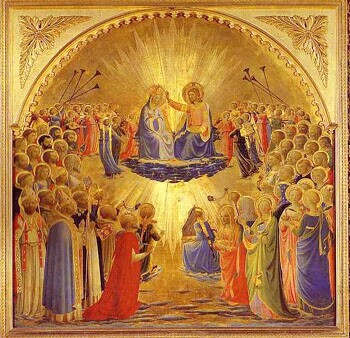 |
Feast Days of Our Lady
The Assumption of Our Lady, August 15
Prof. Plinio Corrêa de Oliveira

Church of Our Lady of the Pleasures built in 1565 in north Brazil to celebrate the Catholic victories over the Protestant invaders
|
One often hears meditations on the sorrows of Our Lady, but people from times past, unlike contemporary men, also used to speak often about the joys of Our Lady. For this reason, one of the most famous sanctuaries in Brazil is the Church of Our Lady of the Pleasures, on Mount Guararapes, erected in honor of her joys.
Today, the feast of the Assumption of Our Lady, let us consider her pleasures. There is a good reason to do this. St. Thomas Aquinas maintains that no one can subsist on earth in complete unhappiness. To support the suffering of life, a person needs to have some pleasure, even if it is small; otherwise a constant and intense sorrow is insupportable. He was not speaking of pleasures as the world imagines them, but about the good Catholic pleasures and joy.
Our Lady had many joys. The Magnificat is the expression of the supreme one, the Incarnation, but there are others, such as those celebrated in the joyful mysteries of the Rosary. None was greater, in a certain sense, than that of the Assumption. About these earthly and celestial pleasures, I will say a word.

The Queen's carriage
used in the coronation ceremony
|
You know about the coronation of the Queen of England – there are films, features, and photo-albums illustrating it. The Queen leaves her palace wearing a diadem and other splendid attire and enters a magnificent golden carriage. The carriage, preceded and followed by a brilliant chivalric cortege, moves along slowly and arrives at Westminster Abbey. The bells ring, the cannons roar. The Queen processes up the central aisle of the Abbey and receives the homage of the nobility, peers of the kingdom, and members of the Royal House. Then the coronation ceremony takes place. After she is crowned and seated on her throne, her joy reaches its apex. Her joy spreads over the city, kingdom and whole world. She is the Queen par excellence and it is a universal celebration of the monarchy.
The joy of the Queen gradually increases as the day progresses. She awakens glad, and her joy swells until the moment of the coronation, when it reaches the pinnacle. Then her triumph is complete, and her joy is one that reflects the dignity, honor and magnificent destiny of ruling a great people.
I am not considering that Queen Elizabeth II is an Anglican being crowned in a religious ceremony conducted by this false religion. I am considering the Catholic England of old that gave birth to this Monarchy, whose ceremonies still smolder under the ashes of that unfortunate Protestant branch. I am reflecting on this coronation as a symbol.
Now, let us consider the Assumption of Our Lady. After her most serene death and resurrection, Our Lady knew that she would be taken to Heaven. She knew because she had reached the summit of her sanctity and wisdom, which communicated to her that the hour of her glorification had come. Also, her love of God had never been so intense and she felt that the moment of the Beatific Vision was near. So, Angels from the highest Choirs came down to bring her solemnly to Heaven.

The Angels bring the
throne of Our Lady up to Heaven
|
I imagine that her angelic carriage, to use a metaphor, was preceded and followed by a cortege of selected Angels, perhaps warrior Angels with many victories against the Devil, similar to the military cortege of the Queen of England. Then she arrived at that most solemn place in Heaven where the inhabitants were gathered to pay her homage. She was received by her chaste spouse, St. Joseph, and together, as in a cathedral, they processed down an aisle among the ordered ensemble of Saints.
As she passed and moved toward the throne of the Holy Trinity, Who awaited her, she received the reverence of all the Saints and Angels. In this cortege of honor, she not only received the homage of each one, but she had a perfect understanding and discernment of what each homage represented. To each Saint or Angel, whom she personally recognized, she gave the proportionate retribution of affection and admiration. She took great joy in this hyperdulia of the inhabitants of Heaven honoring her because she was the Mother of Our Lord Jesus Christ and the creature most faithful to Him.
As the procession came to an end, the feast of the Assumption reached its apex. For the first time Our Lady experienced the Beatific Vision; at that same moment she was received by the Divine Word, the Holy Ghost, and God the Father. They solemnly welcomed her, greeting her as the most beloved Daughter of the Father, the most admirable Mother of the Son, and the most faithful Spouse of the Holy Ghost. Then they proclaimed her Queen of Heaven and Earth. After this proclamation, the Three crowned her as such.
All the preceding steps of her assumption led up to that stupendous end. She ardently desired that end and it enormously pleased her. This hypothetical description gives you a faint idea of the ensemble of joys Our Lady experienced that day.
I want to stress that this is not a hyperbole, an exaggeration. I think that a feast like this actually took place in Heaven as part of the assumption of Our Lady. Her assumption, her glorification, and her coronation were three things that came together in a grand ceremony in Heaven.
A similar glorification will take place at the end of History after the Last Judgment. Following the supreme glorification of Our Lord as King of History and the solemn recognition of His victory over Satan and his cohorts and armies, it is probable that Our Lord will pay a final homage to Our Lady, and again the Holy Trinity will confirm her sovereignty over Heaven and Earth – the glorified Earth at the end of the world.

The Coronation of Our Lady by Fra Angelico
|
It is my opinion that this glorification of Our Lady at her resurrection and assumption had an effect on earth and nature. As at Fatima when the sun changed its colors and danced, twirling toward the earth to confirm the words she spoke to the children, on the day of her assumption, I imagine the sun was shining with a special glorified light, the air was exceptionally pure, and all nature was immensely joyful.
The face of Our Lady before her assumption would have shined with increasing brilliance expressing the great love of God she was feeling, her eagerness to be with Him, and a presentiment of the joys she would shortly have. I think that the last day of Our Lady on earth in a certain sense represents the transfiguration of Our Lady; it was her Tabor. The persons who were with her and saw her would never forget that day for the rest of their lives.
I think that she will communicate to us and to the entire earth, when the Reign of Mary predicted in Fatima will be solemnly established, some of the joy she had on the day of her Assumption and that she now has in Heaven.
There is an invocation in a Litany to Our Lord in which we ask: ut ad celestia desideria erigas, te rogamus, audi nos – that our souls be raised to the desire for celestial things, we pray Thee, hear us. This invocation should be the conclusion of our meditation on the Assumption of Our Lady. We should ask that we may love the celestial happiness of Our Lady to give her glory and that we may one day be with her in Paradise. We should also love and meditate on her joys as a way to accept with peace and resignation the sorrows and sufferings God sends us so that we might prove our love for Him.


  | | Prof. Plinio Corrêa de Oliveira | |
The Saint of the Day features highlights from the lives of saints based on comments made by the late Prof. Plinio Corrêa de Oliveira. Following the example of St. John Bosco who used to make similar talks for the boys of his College, each evening it was Prof. Plinio’s custom to make a short commentary on the lives of the next day’s saint in a meeting for youth in order to encourage them in the practice of virtue and love for the Catholic Church. TIA thought that its readers could profit from these valuable commentaries.
The texts of both the biographical data and the comments come from personal notes taken by Atila S. Guimarães from 1964 to 1995. Given the fact that the source is a personal notebook, it is possible that at times the biographic notes transcribed here will not rigorously follow the original text read by Prof. Plinio. The commentaries have also been adapted and translated for TIA’s site.
|
Saint of the Day | Home | Books | CDs | Search | Contact Us | Donate

© 2002- Tradition in Action, Inc. All Rights Reserved
|
 |

|